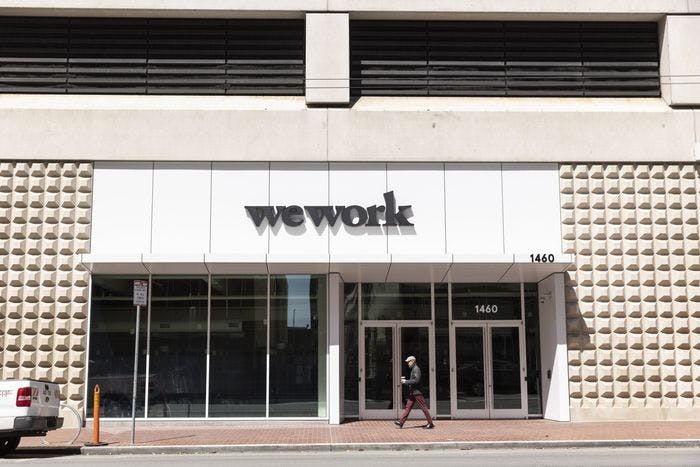3 Reasons Companies Are Adding Flexible Office Solutions To Their Corporate Real Estate Portfolio



With hybrid work quickly becoming the norm, flexible office space has only risen in popularity coming out of the pandemic. The number of people working in coworking spaces, for example, hasn’t just continued to grow steadily—it’s more than tripled since 2015.
According to the hybrid workspace experts at Regus:
- 90% of employees want flexibility in where and when they work
- 30% of global office space will be flexible by 2030 (compared to less than 5% today)
Meanwhile, studies like CBRE’s 2022 Occupier Sentiment Survey show corporate demand for flexible office space is growing. Some 59% of respondents say flex space will make up a significant (10-50%) or very significant (50%+) portion of their corporate real estate portfolios within the next 2 years.
Here are 3 reasons companies are making flex office space an integral part of their corporate real estate portfolio.
1. As-a-service solutions are becoming the norm
Fortune Business Insights has projected that the global XaaS (Everything-as-a-Service) market will skyrocket from $545 billion in 2022 to $2,378 billion by 2029.
In fact, if you look at the shift towards as-a-service solutions across other industries, it should come as no surprise that more companies are viewing real estate as yet another cost center they can leverage on a pay-per-use basis.
Consider, for example, the movement from on-prem to cloud-based solutions. Instead of buying, managing, and ensuring you have enough servers to cover your needs (and likewise—that you’re not wasting money on way more servers than you require), you can now:
- Work with a usage-based, as-a-service provider like AWS
- Reap valuable cost-management benefits
- Let AWS handle the logistical burdens of managing servers and everything else that comes with it
The same premise applies to flexible office space, which is sometimes called “space-as-a-service”. Here’s a telling take on the future of the office from thought leader Dave Cairns:
“The office industry is on a path to becoming Spotify. Eventually we’ll all carry the ‘office’ in our pockets but at the moment the traditional office is experiencing a ‘Napster’ moment [with] the customer of the office (employees) desiring, and actually purchasing workspace like we used to download songs on Napster, on-demand.”
2. Flexible office space offers multiple benefits
Considering real estate is one of the largest line items on a company’s cap table—and especially considering the looming recession, and the general disinterest around returning to the old model of office-based work—organizations gain multiple benefits from adopting flex space solutions.
- Flex space helps companies roll out and manage activity-based working (where specific events trigger real estate expenditures)
- Usage-based workspace solutions unlock significant savings from traditional office rent, upfront capital costs, facilities operations, maintenance, and ongoing management
- Remote employees are empowered with the agency to choose their workplace between WFH or at a flex space
3. Space-as-a-service supports multiple use cases
It’s commonly said that real estate shouldn’t be a one-size-fits-all approach. For any given company, there may be a variety of flex space needs. These flex spaces provide different engagement models and support a variety of different use cases.
Coworking spaces for individuals
Most people prefer to balance WFH with other workplaces. A survey by Slack of 9,000 workers in 6 countries found that only 13% prefer to always work from home if given the choice.
Still, you can expect usage frequency and types of coworking experiences to vary with factors like:
- Job function
- Phase of life
- WFH office setup
- Distractions and obligations at home
- Commuting ability and distance
In markets like New York, for example, where there are more than 450 coworking spaces across the 5 boroughs, generally poor WFH environments—and an easy commute—mean coworking spaces are frequently packed.
Many of these people attend coworking spaces to complete heads-down tasks and may not even be meeting in-person with other colleagues. These coworking spaces also provide people an ability to connect with others in a professional environment and break up the potential solitude of WFH.
Flex spaces for teams
Many companies use flex spaces to facilitate team get-togethers.
Whether it’s a departmental, leadership, geo-specific, or cross-functional gathering — or even an all-company offsite — there are several ways companies leverage flex space for team meetups:
- Rent a conference room or event space
- Purchase a bundle of flex space memberships or day passes
- Combine these two approaches to support both individual work and collaboration
Snagging a more private arrangement, meanwhile, is a great way to make flex space feel like your personal company office for a designated time period.
Get FlexDesk
As you incorporate more flex/coworking spaces into your corporate real estate portfolio, FlexDesk is the ideal platform to manage your flex office needs.
- Search and book from over 7,000 coworking locations
- Track all coworking spend and enforce spend limits
- Consolidate billing into one simple payment
Want to learn more about how companies are navigating and managing the shift to flex/coworking space? Book a FlexDesk demo today!

